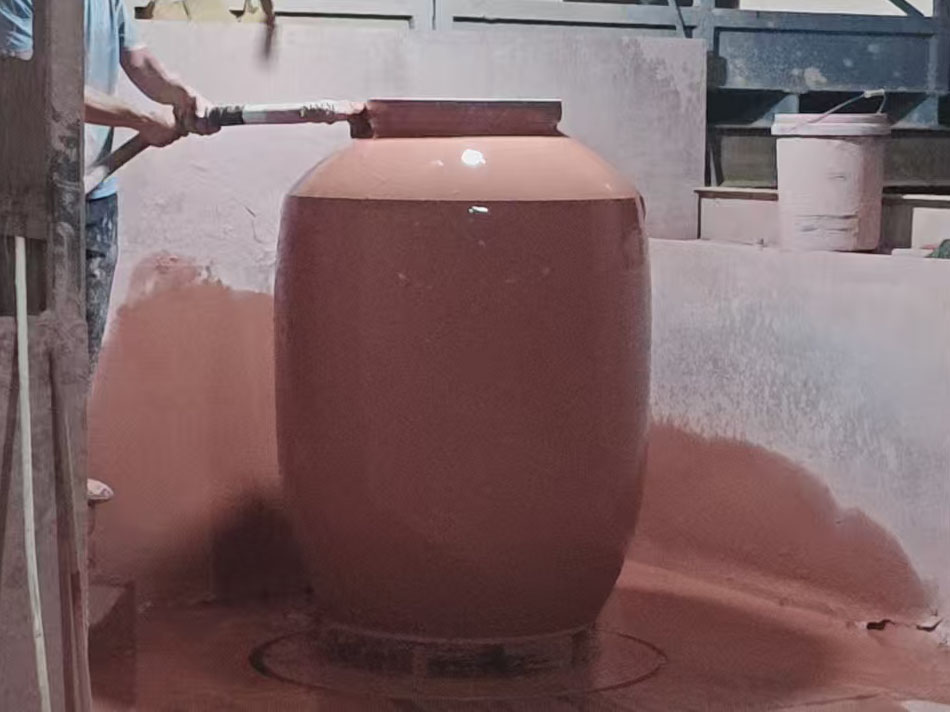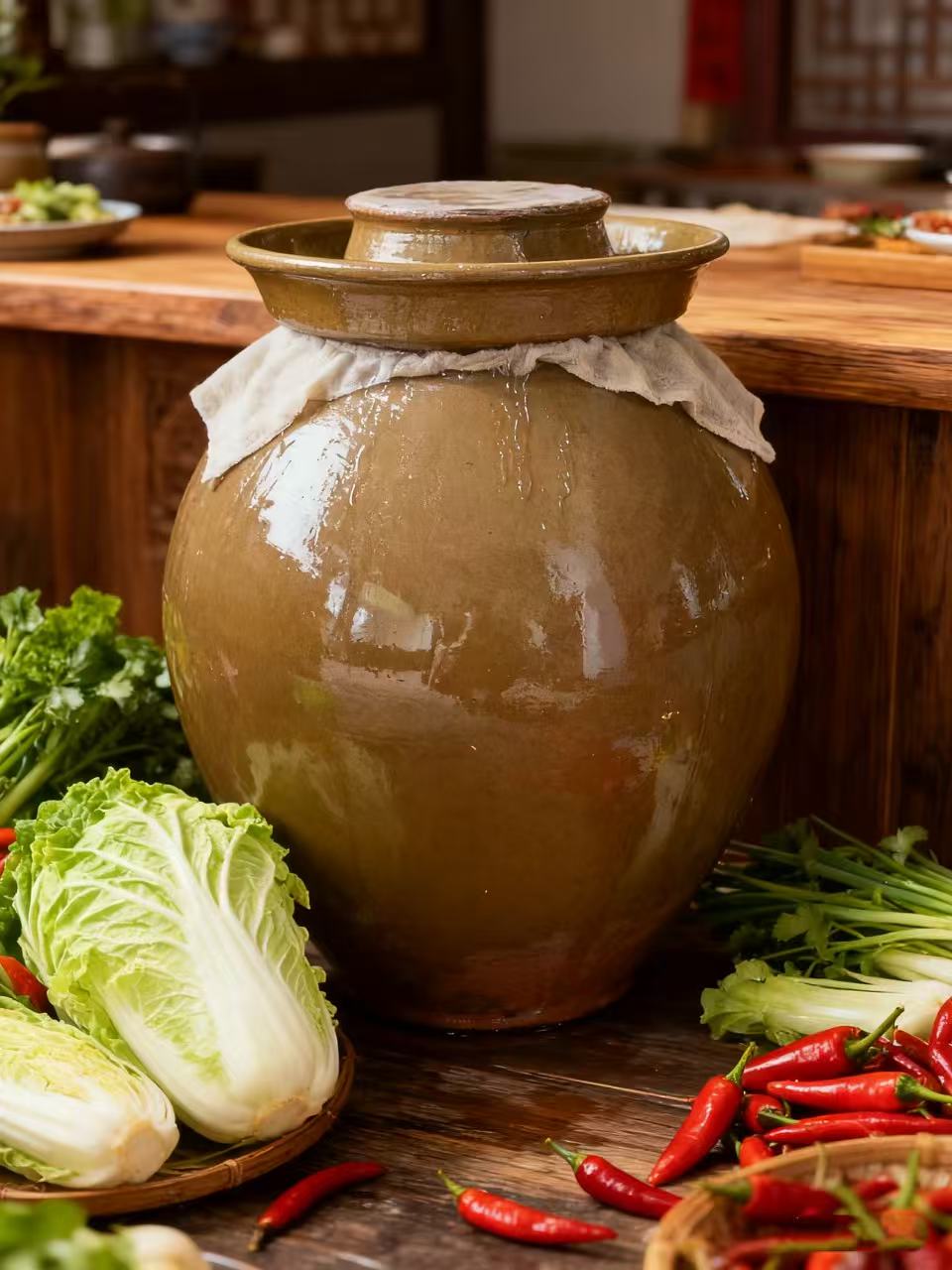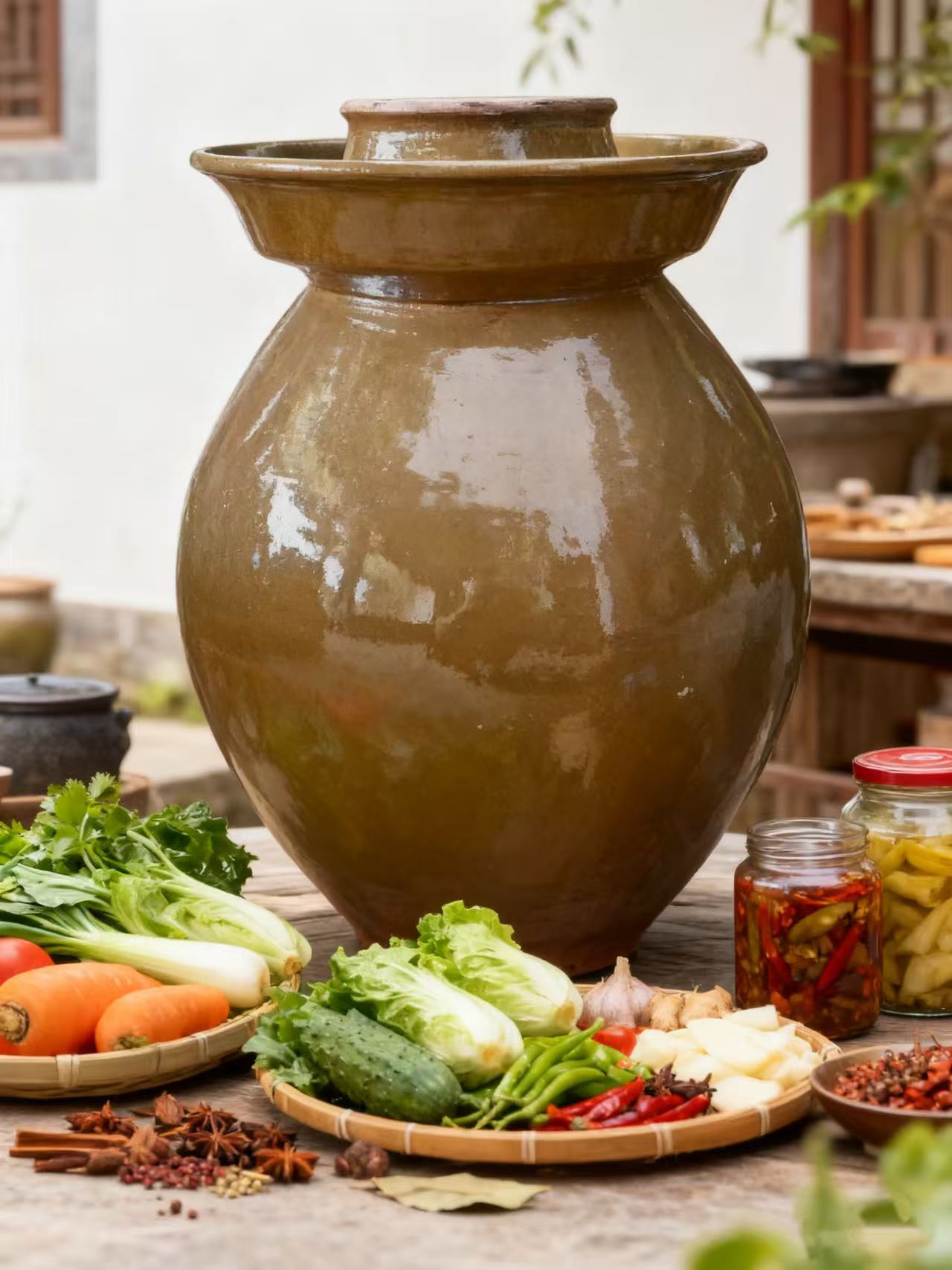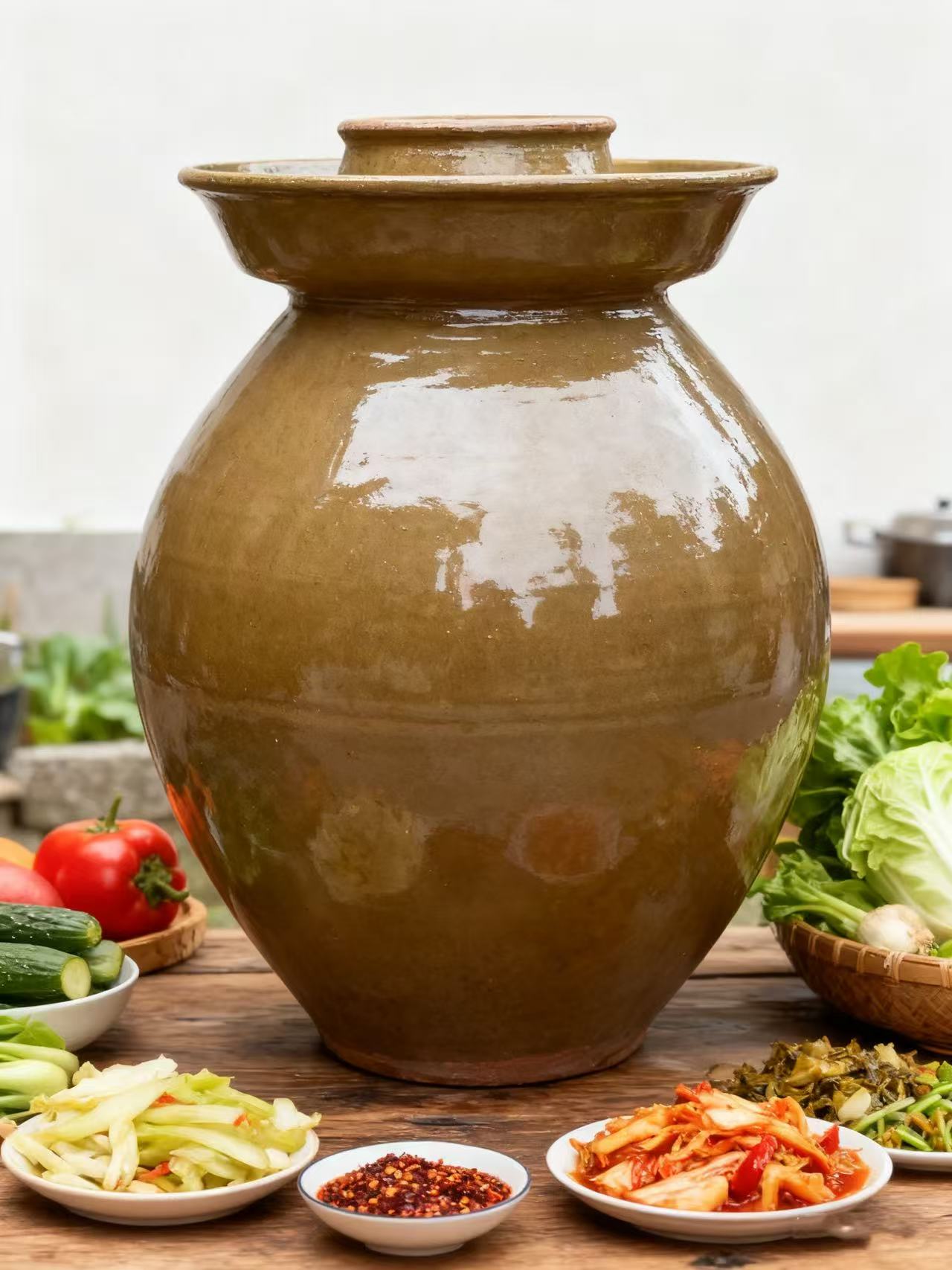The 150L medium glazed kimchi crocks are made of high-quality clay and crafted with exquisite craftsmanship. They have the characteristics of anti leakage, durability, easy cleaning, corrosion resistance, safety and hygiene, and can meet the needs of customers such as boutique restaurants, homestays, and small and micro food workshops. We support personalized customization of products and are committed to providing reliable solutions for traditional food fermentation and storage scenarios worldwide, helping promote the healthy development of the industry.

Our Advantages
Our Manufacturing Advantages
Shunfa is a reliable 150L medium glazed kimchi crocks manufacturer and supplier in China. As a strong ceramic jar factory, it covers an area of 140 acres, has more than 300 craftsmen, and has 4 advanced tunnel kiln processing production lines, which can flexibly meet the product requirements of different specifications of kimchi crocks and support product customization.
● 4 advanced tunnel kiln production lines with an annual production capacity of over 200000 pieces
● Delivery cycle: 30 days
● Minimum order quantity: 50 pieces
● Support size, shape, color, texture, and glaze/unglaze selection
● Capable of providing OEM/ODM private label customization services and capabilities
● Logistics packaging: shockproof and stable packaging solution
● Factory direct selling price, quality assurance
● Provide product testing reports
● Flexibility of Payment Methods: Supports Letter of Credit TT
Core Advantages Of 150L Medium Glazed Kimchi Crocks
Fermentation is more scientific:
Microbial activity: The micropores of clay promote the density of lactic acid bacteria to reach 10 ⁹ CFU/g, while plastic buckets only have 10 ⁷ CFU/g;
Flavor control: In terms of the generation of esters and aldehydes, ceramic jars can produce up to four times more flavor compounds.
Higher economic benefits:
Energy saving: The insulation energy consumption of clay kimchi jars in winter is 87% lower than that of stainless steel barrels;
Loss cost:
More cost-effective. The total cost of a 30-year cycle is only 1/4 of that of a plastic bucket.
Sustainable and stronger:
Carbon reduction: Compare plastic buckets and each ceramic jar to reduce carbon emissions by 24kg throughout their entire lifecycle;
Recycling:
After crushing the damaged cylinder body, it can be used as a soil amendment.
| Comparing dimensions | Clay kimchi jar | plastic bucket | Glass jar | Steel tank |
| Breathability | ● Micro porous oxygen control (0.1-5 μ m pores) | ❌ Completely isolate oxygen | ❌ Completely sealed | ❌ Metal ions inhibit microbial communities |
| Promote synergistic fermentation of aerobic/anaerobic bacteria | Resulting in a single flavor | Restricted microbial activity | ||
| Flavor expression | ★★★★★ | ★★☆ | ★★★☆ | ★★☆ |
| Generate compound ester fragrance substances (such as β – caryophyllene) | Risk of plasticizer contamination and odor | Only basic lactic acid flavor | Metallic odor interferes with fermentation | |
| Temperature Stability | Thermal conductivity 0.8W/m · K | Thermal conductivity coefficient 0.4W/m · K | Thermal conductivity coefficient 1.1W/m · K | Thermal conductivity coefficient 16W/m · K |
| When the environment fluctuates by 10 ℃, the temperature inside the tank is only ± 1.5 ℃ | The temperature difference inside the tank reaches ± 8 ℃ | Temperature difference inside the tank ± 5 ℃ | Temperature difference inside the tank ± 12 ℃ | |
| Health and safety | Mineral slow-release (calcium/magnesium/potassium) | ❌ Risk of microplastic leaching | ● No pollution but no functional addition | ❌ Risk of migration of chromium/nickel ions |
| Support 3% low salt fermentation | (When pH<4.● | |||
| Service life | 15-30 years | 2-3 years | 5-8 years | 8-12 years |
| (1200 ℃ vitrified corrosion resistance) | (Acid corrosion aging) | (Easy to break) | (Weld corrosion) | |
| Daily usage cost | $0.03 | $0.07 | $0.05 | $0.09 |
| (Calculated based on 30 years)“ | ● 100% natural degradation | ❌ Degradation takes 400 years | ⚠️ Non degradable | ⚠️ Difficult to recycle |
| Ecological impact | Carbon footprint 0.8kg CO ₂/piece | Carbon footprint 3.2kg CO ₂/piece | Carbon footprint 2.1kg CO ₂/piece | Carbon footprint 5.6kg CO ₂/piece |
| ★★★★★ | ★☆☆ | ★★☆ | ★★☆ | |
| Commercial premium capability | Handmade glazed color products have a premium of 300-800% | No premium space | Design premium of 50% | Industrial premium of 30% |
150L Medium Glazed Kimchi Crocks
Glaze Technology
Regarding glaze: Glaze is made by grinding mineral raw materials (kaolin) into glaze slurry, which is applied to the surface of the damaged body of the kimchi jar and calcined at high temperature of 1370 ℃.
Process features: It can increase the mechanical strength, thermal stability, and dielectric strength of kimchi jars, as well as beautify the objects, facilitate cleaning, and other characteristics.
Glazing method: Common glazing methods include spraying, oiling, and pouring. Our glazing method uses a self-developed and patented fully automatic spraying machine for glazing.
 Glazing
Glazing
 Kaolin
Kaolin
Core Function Of
150L Medium Glazed Kimchi Crocks
1. Kimchi crocks can effectively optimize the fermentation environment and retain slight breathability.
Kimchi crock is glazed on the outer wall and unglazed on the inner wall, retaining the natural micro porous structure of the clay.
It can balance sealing and breathability, and effectively promote gas (CO ₂) exchange and humidity regulation, avoiding the growth of miscellaneous bacteria.
2. Glazed ceramic jars can enhance leakage prevention and sealing.
The glaze forms a glassy layer, completely blocking the pores of the clay and preventing liquid leakage.
In product design, water sealed grooves or counterweight covers can be used to improve sealing and reduce oxidation risks.
3. Easy to clean and corrosion-resistant.
The smooth glazed surface of the pottery jar is not prone to residual stains, inhibits mold adhesion, and is easy to clean.
It can effectively resist acid corrosion and prevent mineral leaching caused by direct contact with acidic substances in clay.
4. Safety isolation layer to ensure food safety.
Food grade glaze can effectively isolate trace heavy metals such as lead in inferior clay.

The Difference Between
150L Medium Glazed Kimchi Crocks
And Other Containers
| Characteristic | Advantages Of Glazed Pottery Jars | Vs. Unglazed Pottery Jar | Vs. Glass/Plastic |
| Anti Leakage Capability | Thoroughly Solve The Leakage Problem And Can Be Stably Placed On Wooden Floors/Countertops | ❌ In The Initial Stage, It Is Easy For Water To Seep And Requires A Tray To Be Placed | ⭐⭐⭐⭐ Tongyou |
| Cleaning Convenience | Smooth And Stain Resistant Glaze, Easy To Clean With A Wipe | ❌ Porous Structure Is Prone To Odor Absorption And Staining, Making It Difficult To Thoroughly Clean | ⭐⭐⭐⭐ Tongyou |
| Hygienic | Reduce The Risk Of Microbial Hiding | ❌ Pores Are Prone To Mold Growth | ⭐⭐ Plastic Is Prone To Scratching And Harboring Bacteria |
| Durability | Glaze Layer Enhances Surface Hardness And Resistance To Slight Scratches | Bare Pottery Is Easily Scratched By Tools | ❌ Glass Is Fragile/Plastic Is Aging |
| Aesthetic Diversity | Glaze Color Can Be Customized (Celadon/Rough Pottery/Painted), Combining Practicality And Artistic Sense | Plain Pottery Is Simple But Monotonous | ⭐⭐ Design Limitations |
| Cultural Adaptability | Can Integrate East Asian/European Ceramic Styles | Only Available In Traditional Eastern Style | ❌ Lack Of Cultural Symbols |
150L Medium Glazed Kimchi Crocks Are Suitable For Scenes
Glazed fermentation tanks are widely used in the following practical scenarios based on their main characteristics and features:
1. Home fermentation: solving leakage problems, suitable for modern kitchens; Colorful glaze colors enhance kitchen aesthetics
2. Commercial production: comply with food safety production standards (easy to clean, corrosion-resistant), reduce quality inspection risks
3. Catering display: Glazed jars serve as tableware directly on the table (such as serving kimchi platters), enhancing the sense of dining ceremony



Procurement Guide For
150L Medium Glazed Kimchi Crocks
The ceramic jar made of high-quality clay fired at 1370 ℃ not only retains the “breathing sensation” of the clay, but also solves the problems of leakage and hygiene with advanced glaze technology. It has become an upgraded solution that balances fermentation functionality, modern usability, and aesthetic value. It is an ideal choice for home users and compliant food manufacturers who pursue zero leakage and low maintenance. We seek to provide customized solutions for this type of customer worldwide, to help promote healthy career development.
| Parameter | Recommendation | Avoiding Pitfalls Tips |
| Glaze Safety | Inner Wall Unglazed/Lead-Free Matte Glaze | Be Cautious Of Bright Colored Glazes (High Risk Of Lead) |
| Breathable Design | Bare Ceramic Or Breathable Glaze On The Inner Wall | Avoid Bright Inner Walls With Full Glaze |
| Sealing Structure | Water Seal Tank>Counterweight Cover>Ordinary Cover | Flat Cap Requires Additional Weight To Be Pressed |
| Firing Temperature | ≥ 1200 ℃ (Stoneware Grade) | Low Temperature Ceramics (<1000 ℃) Have Low Strength And Are Prone To Leakage |
Does Natural Clay Contain Heavy Metals (Lead, Cadmium)?
Our clay jar glaze comes from kaolin without mining pollution. After grinding, it is made into glaze slurry, which is applied to the surface of the damaged kimchi jar and calcined at 1370 ℃ to solidify harmful substances.
How To Properly Handle Terracotta PotsBefore Their First Use?
1: Soak in clean water for 48 hours (to prevent leakage and remove soil odor).
2: Boil white vinegar and water for disinfection (do not cool or heat rapidly).
3: Use after drying in the shade.
Is It A Quality Issue If White Frost (Salt Precipitation) Or Mold Spots Appear After Long-Term Use?
Due To The Breathability Of Natural Clay, Long-Term Use May Result In White Frost And Mold Spots, Which Are Normal Phenomena. We Provide Timely Consultation Services.
Can We Provide Oem/Odm Services? (Customized Logo, Size, Glaze Color)
We have OEM/ODM service capabilities and can meet the requirements in terms of logo, size, and glaze color, with a minimum order quantity of 50 pieces.
Sample making process: Confirm customized plan – Collect sample fee (deductible for bulk orders) – Confirm production.
Can The Minimum Order Quantity (Moq) Be Reduced?
Standard version: MOQ 50 pieces (can be mixed in color).
Customized version: MOQ 100 pieces (shared mold cost).
